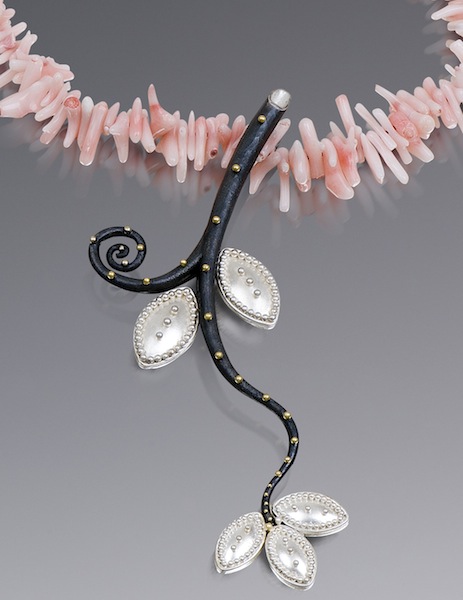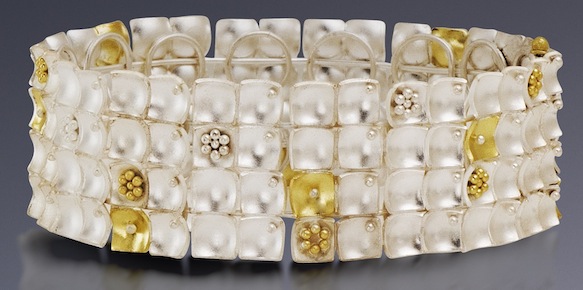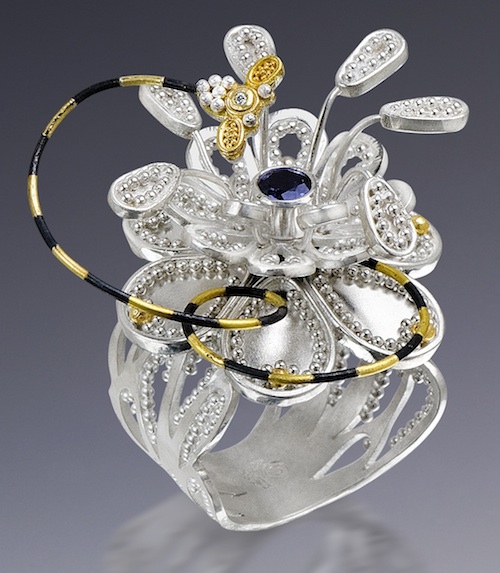
Except for the help of electricity and modern chemistry, most of what jewelry artists do at the bench isn’t all that different from what goldsmiths did in ancient times – filing, soldering, sawing, forging, casting, fusing, hammering and polishing.
That makes it all the more amazing when today’s metalsmiths manage to find new ways to execute these time-honored (and time-consuming) skills to produce jewelry that looks unmistakably au courant.
Sometimes that means using centuries-old Japanese techniques to create something ultra-sleek or organically abstract. Sometimes it means applying ancient European methods we once associated with high-karat gold to new, more affordable metals.
Patricia Tschetter specializes in the latter – the ancient art of granulation using both high-karat gold and a form of fine silver known as Argentium. Her unique, contemporary spin on this ancient technique led to Niche Awards in 2010 and 2011.
Tschetter studied jewelry-making at The Revere Academy in San Francisco, among other places, but learned granulation from a master, the goldsmith Jean Stark, whom Tschetter calls her most influential teacher.
“If you think about it, granulation is just a circle, which is very simple but modern. We didn’t invent it, we’re just updating it.”
Granulation dates to the Etruscans, who invented and then perfected the technique to such a degree that many feel it’s never been matched. “It was so perfect and all they had to work with were bellows and hammers,” says Tschetter, who has become known for the uniquely stylized jewelry she makes with this ancient process.

Scholars believe the Etruscans ground up malachite, somehow figuring out that the copper in malachite lowered the melting temperature of gold, allowing them to fuse the granules. The addition of copper is one aspect of gold granulation that hasn’t changed in 2,000 years, although contemporary designers have found easier ways to add it. Tschetter does it by brushing the granules with old pickle from a copper bowl. Others use a powdered form of copper carbonate.

“I try to give my granulation a more modern feel. I think it lends itself naturally to a very modern way of designing,” she says. “If you think about it, granulation is just a circle, which is very simple but modern. We didn’t invent it, we’re just updating it.”
Nothing looks more modern than granulated white metal, particularly Argentium, something Tschetter has pioneered. It’s not that white metals didn’t exist in ancient times, she points out, just that they didn’t survive. Electrum, a white-metal alloy used by the ancient Greeks, was one exception, perhaps because it had more gold than silver.
Like most goldsmiths, Tschetter started introducing more silver to her jewelry when the price of gold began to skyrocket. After experimenting, she even found ways to granulate with it. In 2007, she won a Saul Bellow award for a necklace of cylindrical beads made with granulated gold and Electrum. But with its 60-percent gold content, Electrum was still pricey – and even trickier to granulate.
 Six years ago, she began granulating with Argentium, a patented white metal made with 93.5 percent pure silver, and soon discovered it required less time, fewer toxic chemicals, and cheaper tools. “Granulation doesn’t get any easier,” she says. “What’s great is that you can granulate with Argentium and you can fuse it, just like high-karat gold. It’s very malleable and has less copper and more germanium, so it doesn’t tarnish like sterling. Yet it takes a patina just like sterling.”
Six years ago, she began granulating with Argentium, a patented white metal made with 93.5 percent pure silver, and soon discovered it required less time, fewer toxic chemicals, and cheaper tools. “Granulation doesn’t get any easier,” she says. “What’s great is that you can granulate with Argentium and you can fuse it, just like high-karat gold. It’s very malleable and has less copper and more germanium, so it doesn’t tarnish like sterling. Yet it takes a patina just like sterling.”
Unlike her gold granulation, which requires copper-plating and an ultra-light kiln, Argentium granules adhere with yellow flux and 30 minutes of cooling on a cold charcoal block. Given that Tschetter tends to fuse rather than solder – “I’m the fusing queen,” she jokes – she loves the fact that she can fuse Argentium and then granulate on top of it. “You can’t do that on sterling,” she points out.
Granulated Argentium is unusually sturdy. With gold granulation, she has to polish before granulating or risk polishing off the granules, but she polishes her granulated Argentium using a 3mm bristle brush. Working with Argentium is also more environmentally friendly than other metals. “You don’t have to use that toxic standard pickle,” she says. “You can just use warm vinegar because you don’t have the copper to take off.

Only tricky part of granulating with Argentium? “It’s extremely brittle when it’s red hot and will literally break if you touch it. Once you get used to that, it’s easier, quicker and requires less clean-up,” she says. “I think once people figure out how easy it is, they’re going to be granulating with this stuff like crazy.”
To see more of Patricia Tschetter’s jewelry, visit her website.
Related posts:
Ancient gold jewelry: timeless beauty, technical mastery
Cornelia Goldsmith: nature with a twist
Snakes and stones: female designers in Bali
Related products:

